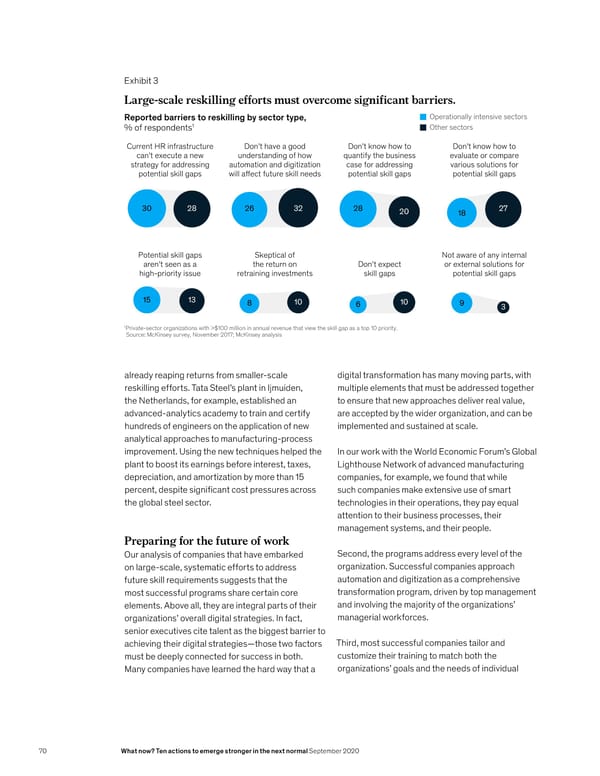Web <2020> Exhibit <3> of <5> Exhibit 3 Large-scale reskilling efforts must overcome significant barriers. Large-scale reskilling efforts must overcome significant barriers. Reported barriers to reskilling by sector type, ƒperationally intensive sectors 1 ƒther sectors % of respondents „urrent …† infrastructure ‰on’t have a good ‰on’t know how to ‰on’t know how to can’t eˆecute a new understanding of how ‹uantify the usiness evaluate or compare strategy for addressing automation and digitization case for addressing various solutions for potential skill gaps will affect future skill needs potential skill gaps potential skill gaps 30 28 26 32 28 20 18 27 Potential skill gaps keptical of ot aware of any internal aren’t seen as a the return on ‰on’t eˆpect or eˆternal solutions for high-priority issue retraining investments skill gaps potential skill gaps 15 13 8 10 6 10 9 3 1Private-sector organizations with >$100 million in annual revenue that view the skill gap as a top 10 priority. ource cinsey survey ovem er 01€‚ cinsey analysis already reaping returns from smaller-scale digital transformation has many moving parts, with reskilling efforts. Tata Steel’s plant in Ijmuiden, multiple elements that must be addressed together the Netherlands, for example, established an to ensure that new approaches deliver real value, advanced-analytics academy to train and certify are accepted by the wider organization, and can be hundreds of engineers on the application of new implemented and sustained at scale. analytical approaches to manufacturing-process improvement. Using the new techniques helped the In our work with the World Economic Forum’s Global plant to boost its earnings before interest, taxes, Lighthouse Network of advanced manufacturing depreciation, and amortization by more than 15 companies, for example, we found that while percent, despite significant cost pressures across such companies make extensive use of smart the global steel sector. technologies in their operations, they pay equal attention to their business processes, their management systems, and their people. Preparing for the future of work Our analysis of companies that have embarked Second, the programs address every level of the on large-scale, systematic efforts to address organization. Successful companies approach future skill requirements suggests that the automation and digitization as a comprehensive most successful programs share certain core transformation program, driven by top management elements. Above all, they are integral parts of their and involving the majority of the organizations’ organizations’ overall digital strategies. In fact, managerial workforces. senior executives cite talent as the biggest barrier to achieving their digital strategies—those two factors Third, most successful companies tailor and must be deeply connected for success in both. customize their training to match both the Many companies have learned the hard way that a organizations’ goals and the needs of individual 70 What now? Ten actions to emerge stronger in the next normal September 2020
 What Now? Page 71 Page 73
What Now? Page 71 Page 73